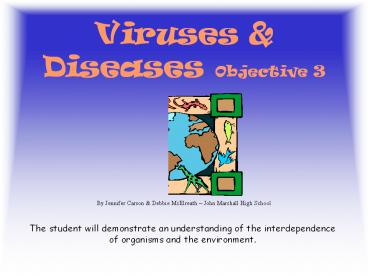Viruses - PowerPoint PPT Presentation
1 / 17
Title:
Viruses
Description:
Viruses & Diseases Objective 3 By Jennifer Carson & Debbie McElreath ~ John Marshall High School The student will demonstrate an understanding of the interdependence ... – PowerPoint PPT presentation
Number of Views:66
Avg rating:3.0/5.0
Title: Viruses
1
Viruses Diseases Objective 3
By Jennifer Carson Debbie McElreath John
Marshall High School
The student will demonstrate an understanding of
the interdependence of organisms and the
environment.
2
Interdependence
Viruses and organisms relyon their
environmentand other species for survival.
3
Viruses
- Viruses are NOT cells. A virus is an infectious
agent made up of - a core of nucleic acid (RNA or DNA)
- a protein coat
4
Alive or not?
Even scientists disagree as to whether or not
viruses are alive. What do you think? Look at the
chart on the next page to help you decide.
5
Characteristic of life
CELL VIRUS
Made of cells YES NO
Obtain use energy YES NO
Grow develop YES Only inside a living cell
Reproduce YES Only inside a living cell
Respond adapt YES YES
Contain RNA or DNA YES YES
6
Structureof a virus
ENVELOPE
- Envelope (part of the protein coat)
- Capsid (part of the protein coat)
- Nucleic acid (either DNA or RNA)
NUCLEIC ACID
CAPSID
7
Retrovirus
CAPSID
- A virus that contains RNA instead of DNA
- Human Immunodeficiency Virus (HIV) is a
retrovirus - HIV causes AIDS
ENVELOPE
RNA
8
Bacteriophage
- A virus that only infects bacteria
CAPSID
HEAD
DNA
CAPSID
TAIL FIBER
9
Ticking time bombs . . .
Viruses do not reproduce. They invade a living
cell and let the cell do the work for them.
10
Lytic Cycle
The viral infection that rapidly kills the host
cell is the lytic cycle.
11
Cycle Illustration
1
2
3
4
5
12
Lysogenic Cycle
The viral infection that enters a cell, remains
harmless for a period of time (sometimes years),
and then becomes harmful later is called the
lysogenic cycle.
13
Role of viruses
- All viruses act like parasites, harming the host
cell. - Viruses cause disease in every kind of
organismanimals, plants, fungi, protists, and
bacteria.
14
Some viral diseases
- HIV
- Measles
- Smallpox
- Influenza
- Chicken pox
- Common cold
- Herpes
- Warts
- Mononucleosis
- Mumps
15
Viral diseases
- usually cannot be cured, but many can be
prevented by - Good hygiene
- Immunization
16
Links
http//www.virology.net/Big_Virology/BVFamilyIndex
.html
17
Sources
http//www.virology.net/Big_Virology/BVFamilyIndex
.html Biology, Kenneth R. Miller Joseph
Levine, 1991, Prentice-Hall, Inc., Englewood
Cliffs NJ. Biology The Web of Life, Eric
Strauss Marylin Lisowski, 1998, Scott Foresman
Addison Wesley, Menlo Park CA TAKS Power Tools,
Glencoe Science, Glencoe McGraw-Hill, 2001, New
York, NY. Microsoft Office Clipart































